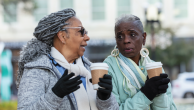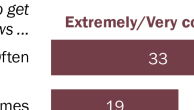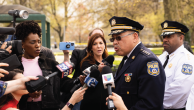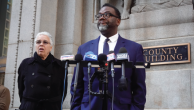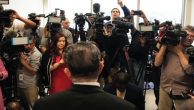Like many aspects of U.S. society, coverage of the nation’s statehouses appears to have been significantly – and perhaps permanently – affected by the coronavirus pandemic. Amid shutdowns of capitols, shifting public health protocols inside those buildings and COVID-19 outbreaks within statehouses, legislators and state officials, along with the reporters who cover them, have increasingly done their jobs from remote locations.
Details about these interviews
As part of this report, Pew Research Center conducted and recorded interviews from August 2021 through February 2022 with 24 individuals involved in statehouse coverage. The majority of them work for news outlets, but a few work as either a legislative leader’s chief of staff or a statehouse communications official. Interviewees were selected from study respondents with the goal of representing a range of states, outlet types and outlet sizes, among other factors. The interviews took between 20 to 30 minutes. For more details about the qualitative interview parameters, see the Methodology.
To better understand these changes, researchers conducted two dozen interviews with statehouse reporters and staff. It is clear from the conversations that responses to the COVID-19 outbreak varied from statehouse to statehouse, often depending on its political makeup. But several key themes emerged about the realities of covering state legislative politics in the midst of a lengthy and evolving pandemic. These realities included:
- The expanded use of livestreaming or other online platforms for legislative meetings and sessions;
- The reduction of in-person contact between reporters, legislators and state officials;
- A change in work habits of some statehouse journalists and an opportunity to rethink how they do their jobs; and
- The public policy debate over COVID-19 protocols as a major topic of coverage for journalists reporting on state politics.
Describing these uncertain and changing circumstances, Betsy Russell, president of the Idaho Capitol Correspondents Association, recounted how an early 2021 legislative session in her state opened with “basically no precautions,’’ and then had to be shut down after a major COVID-19 outbreak infected scores inside the Capitol. “Nothing like that has ever happened,” said Russell, who covered her first Idaho legislative session in 1986.
Chad Blair, the politics and opinion editor of Honolulu Civil Beat, described a similar pandemic disruption at Hawaii’s Capitol. “We all went into emergency lockdown period with the Capitol itself. It actually had to be evacuated when a state senator tested positive. He had visited Las Vegas, came back, wasn’t feeling well, got a test, and then they just flat-out shut down the Capitol completely,” Blair said. “Essentially business had to stop because of COVID.”
An expansion of livestreaming and other video platforms
While COVID-19 created chaos and forced reporters, at least temporarily, out of many U.S. statehouses, some of those interviewed said the outcomes were not all bad. The pandemic triggered much more extensive live video coverage of legislative meetings and sessions – a decision that enabled more live public access to the workings of state government and helped journalists function more efficiently in a difficult environment.
Jason Thompson, communications director for Pennsylvania Senate President Pro Tempore Jake Corman, quantified the expansion of livestreaming during the pandemic: He said the Pennsylvania State Senate livestreamed more than 300 meetings in 2021, including every Senate session and almost every committee hearing.
Thompson believes that the initiative produced more public engagement, adding that he sometimes saw a substantial number of citizens “tuning in to watch during the course of a committee hearing, which is something that was relatively unheard of before COVID. … It’s been by necessity, but it’s been a great public access tool.”
Some statehouse journalists say the more extensive livestreaming helped them do their job during the strain of the pandemic.
Before COVID-19 struck, the Delaware General Assembly did not offer video livestreaming of proceedings, but after the building was shut down by the pandemic, “they transitioned pretty much immediately to Zoom and some version of livestreaming,” said Sarah Gamard, a former state government reporter for the News Journal of Wilmington. “They’ve upgraded their technology over the past two years.”
Gamard, who said the legislature may have been planning more livestreaming even before COVID-19, characterized the video livestream as a big improvement over audio-only recordings. “You can get the video; you can see who’s talking. It’s even archived to show if you want to only look up a certain bill. You can click on the timestamp of the bill, and it’s already laid out for you. It’s very convenient.”
Annmarie Timmins, a veteran statehouse reporter who is now a senior reporter at the 1-year-old nonprofit New Hampshire Bulletin, said that as a result of COVID-19, “legislators were meeting remotely over Zoom. The remote piece, I liked it. It also allowed [reporters] to be in two places at once because we could record one [meeting] and then be in another and multitask.”
Addressing the public benefits of livestreaming the meetings, Timmins said she wrote a story “on what that remote access did for being able to have the public engaged in democracy.”
A reduction in personal contact
While livestreaming and other digital platforms may have helped journalists cover meetings when they weren’t in the building, a number of those interviewed said the pandemic significantly reduced their opportunities to personally approach and talk with legislators and officials – interactions that can improve the quality of reporting.
“Since COVID hit, I could count the number of days, quite frankly, that I’ve been in the State Capitol on two hands,” said Gary Warner, who covers Oregon politics for the EO Media Group. “The State Capitol was closed to the public [with] very limited access to the press.”
“In some ways it’s easier, because everybody expects that you’re going to have to get phone calls, you’re going to have to exchange messages,” Warner continued. “At the same time, you lose that ability to go sit in a lawmaker’s office and just chat up.”
Noting the impact of the pandemic on reporting in the Pennsylvania Capitol, Thompson observed that “working in the building is a bit of a challenge. Even today, a lot of Senate offices … are dark on non-session days. … I’m sure it creates a challenge for [reporters] in getting ahold of the folks they need to get ahold of.”
The physical distancing between reporters and legislators during the COVID-19 pandemic may be exacerbating a problem that observers also attribute to the reduced contingent of statehouse reporters in many states: There is less relationship-building between reporters and those they cover.
“I think that the downside of having fewer reporters is, again, there’s probably less effort and availability for reporters to build those relationships” with legislators, said Mat Bahl, chief of staff for Florida’s House speaker. Many rank-and-file members of the Florida House, he added, “probably don’t have very many interactions with the press.”
New work habits and approaches
For many statehouse journalists, the COVID-19 pandemic forced basic changes in where and how they work. Whether these changes endure after the pandemic subsides is uncertain. But from the interviews, it is clear that some journalists are rethinking how best to do their jobs.
“Before the pandemic, I worked in the Capitol every day,” said Jeremy Turley, the Bismarck, North Dakota, correspondent for Forum News Service. “During the pandemic, I started working at home and realized I was more productive … with the caveat that during the legislative session, I was in the Capitol every day.”
The North Dakota Legislature meets for four months every two years, and with no legislative session scheduled this year, Turley said he doesn’t plan on working steadily out of the Capitol until 2023. Once the session starts, however, “it helps a lot to be 100 feet away from where the story is,” he said.
Olivia Krauth is an education reporter at the Courier-Journal in Louisville, Kentucky, whose work sometimes takes her to the Capitol, a 50-minute commute from her home. During the course of the pandemic, she began watching more livestreamed events and going to the building less often. She pointed out that the teachers she would interview when they showed up at the statehouse for key votes or protests could no longer be there when the building was shut to the public.
Now, Krauth is more conscious about what stories require her presence at the statehouse, adding, “It’s just been a decision I make with my editor about, ‘Okay, we really need to limit how often we’re there.’ I’m still there if it’s a really big deal, something like that.”
When Oregon’s Capitol shut down to the public for more than a year, and with reporters’ and legislators’ access to the building greatly reduced, Warner, a veteran reporter in his 60s, changed his schedule.
“Because, frankly, [of] my age, my boss and I decided that I would cover the state politics beat primarily via … the Oregon Legislature’s website that has livestreaming of virtual committee hearings and the few floor sessions,” Warner said. “I’ve also used agency and executive office systems for interviews, press calls and briefings. I do interviews by Zoom or cell call. I’ll swap text messages and emails.”
Covering COVID-19: A big part of a statehouse reporter’s job
During the pandemic, many statehouses became ground zero in the public policy battles over COVID-19 protocols – from shutdowns to mask mandates to school closings – with legislatures, and particularly governors, at the forefront of these debates. Reporters say that has added a major new subject to the list of stories dominating statehouse coverage.
“Just the politics of getting vaccinated has been incredibly contentious,” said Timmins, of the New Hampshire Bulletin, who covers the pandemic as part of her beat. “There’s over 30 bills coming up this next session, just on vaccines. Should they be mandated? Should they be outlawed? There was a lot of legislation last year around trying to stop the governor from having too much executive authority. … COVID really dominated a lot last year.”
As Seattle Times statehouse reporter Joseph O’Sullivan explained, “First of all, COVID was just such a big increase in coverage because all of the statewide orders were coming from Olympia and the governor. That added breaking news, but also a ton of enterprise and investigative coverage looking into these things.”
O’Sullivan also cited “massive” pandemic-related protests against a governor (Jay Inslee), who implemented “some of the strictest COVID-19 rules through the entire pandemic. … Between COVID and the rising political turbulence, the range of [topics] we’re covering [now] is much broader. Now we’re even busier.”
Krauth, of the Courier-Journal in Louisville, said that the pandemic has become a key topic in Kentucky state politics, one driven by the state’s increasingly rare divided state government. “We have a Democrat governor and a Republican supermajority in the statehouse. They have had some issues determining what’s worthy of the mandate [and] who gets to determine the state policies, and that’s still going on.”
For his part, Warner estimated that since 2020, roughly half of the coverage of state politics in Oregon has been about COVID-19 because the state has been under a state of emergency since March 2020, and “all of the decisions come out [of] Salem and out of the governor’s office.”
Russell, a veteran Idaho statehouse correspondent, provided a sense of the persistence of the COVID-19 storyline by describing what happened when the statehouse reopened following a major outbreak. “They shut everything down and then they came back, and they fought some more about how we shouldn’t do anything to respond to COVID.”
